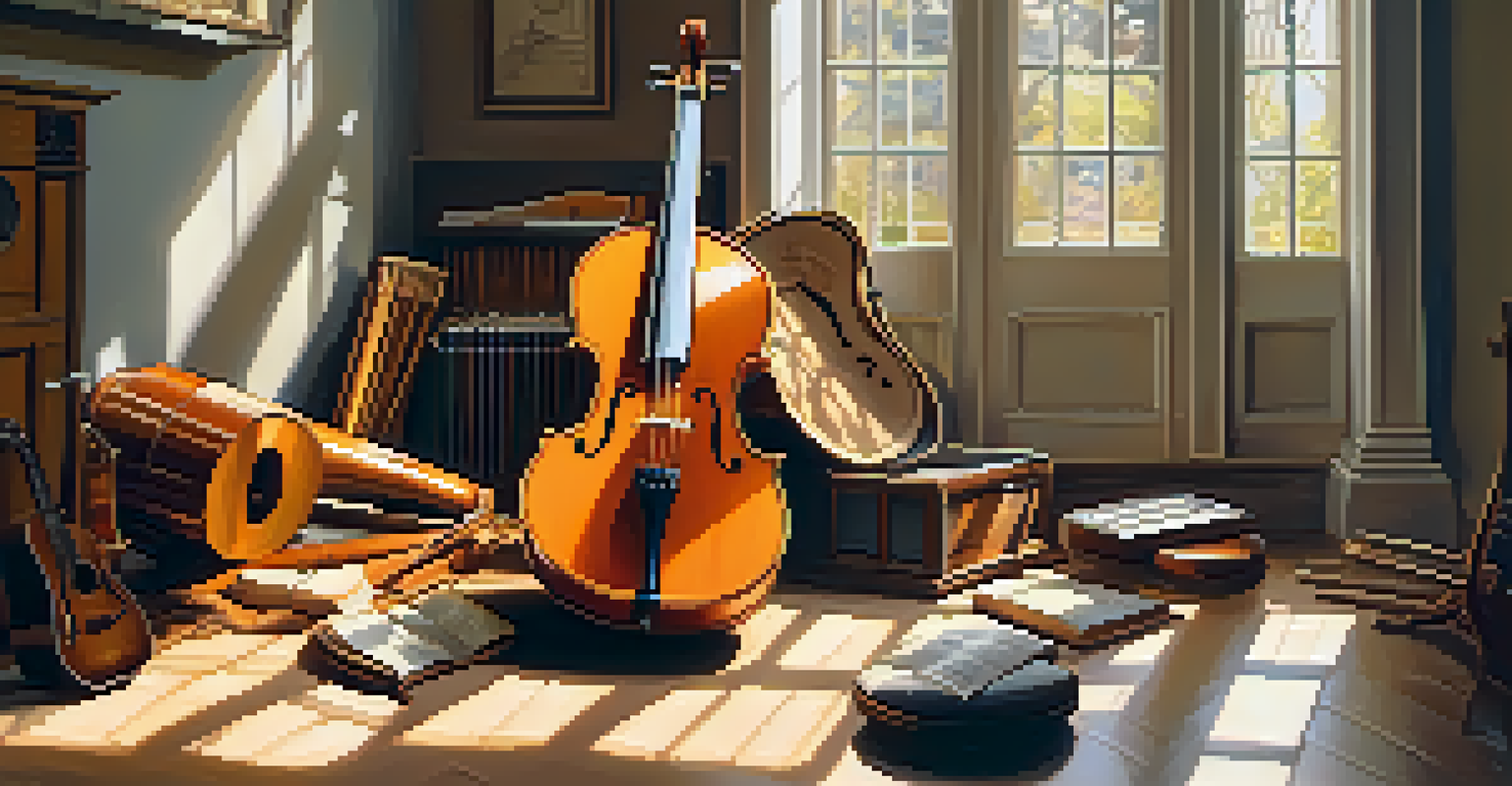The Use of Silence in Music: Crafting Pauses for Effect

Understanding Silence: The Unsung Hero of Music
Silence in music is often overlooked, yet it plays a crucial role in creating emotional depth. Much like a blank canvas can enhance the beauty of a painting, silence can amplify the notes that follow. This absence of sound allows listeners to reflect and engage with the music on a deeper level. It's not just about what is played, but also about what is left unsaid.
Silence is the music of the spheres.
Consider the famous composer John Cage, who famously composed '4'33'', a piece where musicians do not play their instruments for four minutes and thirty-three seconds. This radical use of silence challenges our perceptions of music and invites us to appreciate the ambient sounds around us. It illustrates how silence can provoke thought and stir emotions, making it an essential element in any musical composition.
Moreover, silence acts as a powerful contrast to sound, creating tension and release. When a song suddenly drops to silence, it heightens the anticipation for what comes next. This dynamic interplay between sound and silence keeps listeners engaged and adds layers of complexity to the music.
Crafting Pauses: Techniques in Composition
Composers often use intentional pauses to enhance their musical storytelling. These crafted silences can serve various purposes, from emphasizing a lyrical moment to allowing the audience to process a powerful message. For instance, a well-timed rest can make a chorus feel more impactful, as it gives listeners a moment to breathe before the next wave of sound.

One technique musicians employ is the use of 'fermata,' a symbol indicating that a note or rest should be held longer than its typical duration. This gives performers the freedom to stretch a moment, creating a sense of anticipation. When executed thoughtfully, these pauses can evoke strong emotions and draw listeners into the experience.
Silence Enhances Musical Emotion
Silence plays a crucial role in deepening emotional connections in music by allowing listeners to reflect and engage with the sound.
Additionally, silence can guide the pacing of a piece. Just as a writer uses punctuation to control the flow of a story, musicians use silence to shape the rhythm and structure of their compositions. By incorporating pauses, composers can create dramatic tension that keeps their audience on the edge of their seats.
Silence as a Tool for Emotional Expression
Silence can evoke powerful emotions, often serving as a canvas for feelings that words cannot express. For example, in a ballad, a moment of silence can signify heartbreak or longing, allowing the listener to feel the weight of the emotions. This emotional impact is amplified when silence is juxtaposed with poignant melodies or lyrics.
In music, silence is more important than sound.
Consider how a dramatic pause can transform a sad song into a profound experience. When an artist holds a note just a moment longer, it can resonate deeply with the audience, making them feel as if they are sharing in the artist's pain or joy. It's a testament to how silence can be just as expressive as sound.
In film scores, silence plays a pivotal role in enhancing the emotional landscape of a scene. A quiet moment can heighten suspense or signify a character’s inner turmoil, making the ensuing music even more impactful. This strategic use of silence allows composers to craft a more immersive experience for viewers.
Cultural Perspectives on Silence in Music
Different cultures have varying interpretations of silence in music, which can shape how it is used and experienced. For instance, in Japanese traditional music, silence is often as significant as sound, embodying the concept of 'ma'—the space between notes that creates depth and meaning. This cultural appreciation for silence encourages listeners to engage with music in a unique way.
In contrast, Western classical music has historically celebrated the continuity of sound, yet even within this tradition, silence has its place. Composers like Beethoven and Mahler utilized silence to create dramatic contrasts within their symphonies. This illustrates that while cultural contexts may differ, the power of silence transcends boundaries.
Cultural Views Shape Silence Use
Different cultures interpret silence uniquely in music, influencing how it is used to convey meaning and emotional depth.
Exploring these cultural perspectives enriches our understanding of music as a universal language. It reminds us that silence is not merely an absence but an integral part of expression that can convey a wide range of meanings across different musical styles.
The Role of Silence in Modern Music Genres
Modern music genres, from pop to hip-hop, frequently incorporate silence as a stylistic choice. Artists like Billie Eilish have mastered the art of using silence to create intimacy in their songs, drawing listeners into their world. These quiet moments can create a sense of vulnerability, making the lyrics hit harder and resonate more deeply.
In hip-hop, silence is often used to build tension before a beat drop, enhancing the overall impact of the track. This strategic use of pauses not only showcases the artist’s lyrical prowess but also elevates the listening experience. It’s a reminder that silence is a powerful tool in crafting memorable music.
Furthermore, silence in electronic music can serve to create dynamic soundscapes. Producers might incorporate abrupt pauses or minimalistic sections to enhance the ebb and flow of a track. This ability to play with silence allows for a more immersive and engaging experience, demonstrating that the absence of sound can be just as captivating as its presence.
Psychological Effects of Silence in Music
The psychological impact of silence in music is fascinating and multifaceted. Research suggests that silence can evoke a range of emotional responses, from comfort to discomfort. For instance, a sudden silence in a song can trigger introspection, prompting listeners to reflect on their own feelings and experiences.
This psychological connection can be particularly strong in therapeutic settings, where music is used to facilitate emotional healing. Silence can create a safe space for individuals to confront their emotions, making it an invaluable tool in music therapy. By allowing moments of quiet, therapists can help clients process their feelings more effectively.
Silence as a Modern Music Tool
Contemporary artists leverage silence as a stylistic choice to create intimacy, build tension, and enhance the overall listening experience.
Moreover, silence can also foster a sense of mindfulness. In a world filled with noise, the use of silence in music encourages listeners to be present in the moment. This practice not only enhances the listening experience but also promotes emotional well-being, showcasing the profound effects that silence can have on our psyche.
Embracing Silence: The Future of Music
As the music industry evolves, the role of silence is likely to gain even more prominence. With the rise of streaming platforms, artists have the freedom to experiment with their soundscapes, often incorporating extended pauses and silence as a creative choice. This shift encourages innovation and opens new avenues for artistic expression.
Moreover, as listeners increasingly seek deeper emotional connections with music, the use of silence may become a more prevalent tool for artists. By embracing silence, musicians can craft more meaningful experiences that resonate with their audiences, fostering a deeper understanding of their art.

In conclusion, the use of silence in music is not just a trend; it's a timeless technique that enhances the emotional and psychological impact of compositions. As we move forward, embracing silence will continue to be essential in crafting music that speaks to the heart and soul.